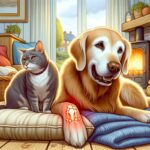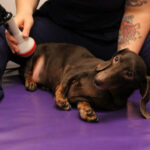Take Home Facts:
-Signs of osteoarthritis may be subtle and easy to miss
-Early treatment is critical to slow progression of the disease
-Maintaining lean body weight is absolutely critical for arthritic patients
-Newer concepts of arthritis management involve proper exercise to maintain muscle mass and decrease pain
-Structure-modifying agents are most effective when started early and maintained long term
-Nonsteroidal anti-inflammatory and analgesic drugs, acupuncture, and physical therapy may be recommended for later stages of the disease
What is Arthritis (also known as Osteoarthritis)?
Osteoarthritis is a chronic degenerative disease that may affect any joint but is commonly found in a pet’s hip, elbow, shoulder, stifle (knee) , carpus (wrist), hock (ankle) or intervertebral joints (in the spine). It occurs when cartilage in the joint is damaged, either following a traumatic event or with wear and tear that increases in athletic animals, obese animals, or when the joint is congenitally abnormal.
Cartilage decreases joint stress by reducing impact on the ends of the bones in joints, like a gelatinous shock absorber. When cartilage is damaged, a cascade of inflammatory changes occurs, eventually leading to destruction of the cartilage and subsequent damage to the underlying bone. Cartilage contains no nerves – if your pet is showing any signs of pain, the damage and changes in underlying bone have already begun.
Signs of arthritis include:
Reluctance to take walks of usual length
Stiffness (that may disappear once the pet has ‘warmed up’)
Difficulty climbing stairs, climbing in the car, on the bed or a sofa
Difficulty rising from rest
Limping
Abnormal gait
Licking of a single joint
Acting withdrawn, spending less time playing with family (which is often misunderstood as a sign of ‘aging’)
Soreness when touched
Rarely, aggression when touched or approached
What to do?
Weight Reduction: Ask your doctor about your pet’s body condition score (BCS), which should be normal (5/9) or slightly underweight (4/9). If your pet is overweight, discuss a weight loss diet with your veterinarian.
Controlled Exercise: Low-impact exercise is best; swimming or walking through shallow water is ideal. Leash walking and controlled jogging are also acceptable.
Nutraceuticals: Synergistic combinations of nutraceuticals such as glucosamine/chondroitin sulfate contain compounds that support cartilage structure, prevent further deterioration, suppress inflammation, and reduce free radical damage.
Injectable Chondroprotective Agent: Talk to your veterinarian about an injectable agent that may also help preserve cartilage in the joints.
Acupuncture and Massage: Both of these therapies may provide additional non-drug pain control.
Prescription Drugs: Drugs are available that can reduce inflammation and suppress pain in dogs with more advanced disease. Side effects can be minimized by monitoring your dog’s blood work regularly.
Call Urban Animal Veterinary Hospital in the Heights and schedule an appointment so we can diagnose and help.



